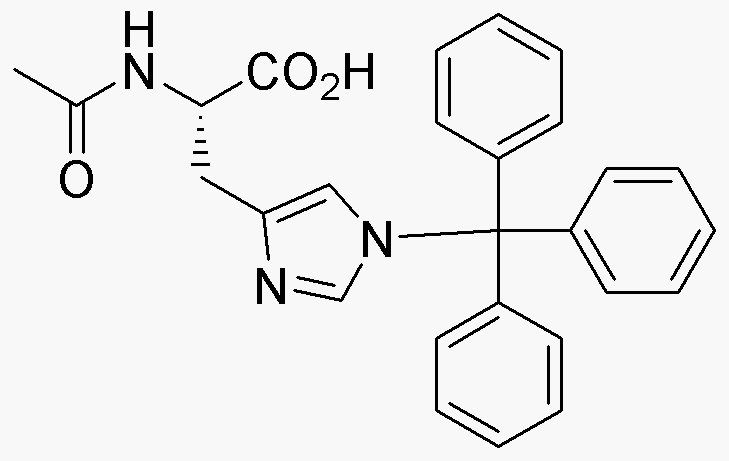Na-Acetyl-Nim-trityl-L-histidine is widely utilized in research focused on:
- Peptide Synthesis: This compound serves as a valuable building block in the synthesis of peptides, particularly in the development of therapeutic agents targeting specific biological pathways.
- Drug Development: Its unique structure allows for modifications that enhance the bioavailability and efficacy of drug candidates, making it a crucial component in pharmaceutical research.
- Biochemical Studies: Researchers use this compound to study protein interactions and enzyme activities, providing insights into cellular mechanisms and potential disease treatments.
- Diagnostics: It can be employed in the development of diagnostic tools, particularly in assays that require specific binding interactions, improving the accuracy of disease detection.
- Research in Cancer Therapy: The compound shows promise in cancer research, where it can be utilized to design targeted therapies that minimize side effects while maximizing treatment effectiveness.
General Information
Properties
Safety and Regulations
Applications
Na-Acetyl-Nim-trityl-L-histidine is widely utilized in research focused on:
- Peptide Synthesis: This compound serves as a valuable building block in the synthesis of peptides, particularly in the development of therapeutic agents targeting specific biological pathways.
- Drug Development: Its unique structure allows for modifications that enhance the bioavailability and efficacy of drug candidates, making it a crucial component in pharmaceutical research.
- Biochemical Studies: Researchers use this compound to study protein interactions and enzyme activities, providing insights into cellular mechanisms and potential disease treatments.
- Diagnostics: It can be employed in the development of diagnostic tools, particularly in assays that require specific binding interactions, improving the accuracy of disease detection.
- Research in Cancer Therapy: The compound shows promise in cancer research, where it can be utilized to design targeted therapies that minimize side effects while maximizing treatment effectiveness.
Documents
Safety Data Sheets (SDS)
The SDS provides comprehensive safety information on handling, storage, and disposal of the product.
Product Specification (PS)
The PS provides a comprehensive breakdown of the product’s properties, including chemical composition, physical state, purity, and storage requirements. It also details acceptable quality ranges and the product's intended applications.
Certificates of Analysis (COA)
Search for Certificates of Analysis (COA) by entering the products Lot Number. Lot and Batch Numbers can be found on a product’s label following the words ‘Lot’ or ‘Batch’.
*Catalog Number
*Lot Number
Certificates Of Origin (COO)
This COO confirms the country where the product was manufactured, and also details the materials and components used in it and whether it is derived from natural, synthetic, or other specific sources. This certificate may be required for customs, trade, and regulatory compliance.
*Catalog Number
*Lot Number
Safety Data Sheets (SDS)
The SDS provides comprehensive safety information on handling, storage, and disposal of the product.
DownloadProduct Specification (PS)
The PS provides a comprehensive breakdown of the product’s properties, including chemical composition, physical state, purity, and storage requirements. It also details acceptable quality ranges and the product's intended applications.
DownloadCertificates of Analysis (COA)
Search for Certificates of Analysis (COA) by entering the products Lot Number. Lot and Batch Numbers can be found on a product’s label following the words ‘Lot’ or ‘Batch’.
*Catalog Number
*Lot Number
Certificates Of Origin (COO)
This COO confirms the country where the product was manufactured, and also details the materials and components used in it and whether it is derived from natural, synthetic, or other specific sources. This certificate may be required for customs, trade, and regulatory compliance.


